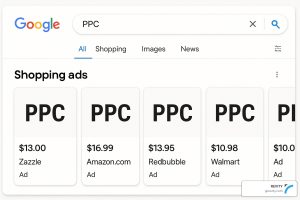Developing a successful PPC campaign requires a strategic approach that considers various factors. From creating compelling ad copy to establishing a realistic budget and bid strategy, there are many elements to consider when developing a PPC campaign that drives results for your business.
In this blog, we’ll explore some of the key tactics and strategies that can help you create a successful PPC campaign. From analyzing your competitors to tracking and analyzing your ad performance, we’ll cover everything you need to know to develop a winning PPC campaign.
What Is PPC Advertising?
PPC (pay-per-click) advertising is an online advertising model that allows advertisers to place ads on search engine results pages (SERPs), social media platforms, and other websites. In this model, advertisers only pay when users click on one of their ads.
Advertisers typically bid on specific keywords or phrases relevant to their target audience to create a PPC ad. When a user searches for those keywords or phrases, the search engine or platform displays the ads that are most relevant to the user’s search query. The ads are usually displayed at the top or bottom of the search results page or on the sidebar of a website.
PPC advertising can be highly effective for businesses of all sizes because it allows advertisers to control their budgets, target specific demographics, and track their performance with detailed analytics.
Advertisers can set a maximum bid for each keyword, which determines how much they are willing to pay for each click. They can also set a daily or monthly budget, limiting the amount they are willing to spend on their ads.
In addition to keyword targeting, PPC advertising allows advertisers to target specific demographics, such as age, gender, location, and interests. This targeting can be done through the platform’s ad settings or by creating custom audiences based on user data.
PPC advertising also provides detailed analytics that allows advertisers to track their performance and optimize their campaigns. Advertisers can see metrics such as the number of clicks, impressions, click-through rate (CTR), and conversion rate. They can also use A/B testing to experiment with different ad copy, landing pages, and targeting strategies to improve their performance over time.
Overall, PPC advertising is a powerful tool for businesses looking to reach a targeted audience and drive traffic to their website. Advertisers can create highly effective campaigns that generate leads, sales, and revenue by carefully selecting keywords, targeting specific demographics, and tracking their performance.
11 Things to Consider for Your PPC Strategy
When it comes to your PPC strategy, there are 11 primary things you need to consider, from having clear goals and objectives to identifying your target audience to remarketing and retargeting. Following these steps will take your PPC campaign to the next level.
1. Have Clear Goals and Objectives
Having clear goals and objectives is essential for any successful PPC campaign. With a clear understanding of what you want to achieve, developing a strategy that drives results is easier. We recommend taking the following steps:
- Define your overall business objectives: Start by defining your overall business objectives, such as increasing sales, generating leads, or improving brand awareness. Your PPC campaign should align with these objectives.
- Identify specific goals for your PPC campaign: Once you have defined your overall objectives, identify specific goals for your PPC campaign. For example, if your aim is to increase sales, your specific goal might be to achieve a certain number of conversions or a specific conversion rate.
- Make your goals SMART: To ensure that your goals are clear and measurable, make them SMART (specific, measurable, attainable, relevant, and time-bound). For example, “Increase website sales by 20% within the next three months” is a SMART goal.
- Use data to inform your goals: Use data from previous campaigns, industry benchmarks, and audience research to inform your goals. This will help you set realistic targets and ensure your goals are achievable.
- Monitor and adjust your goals over time: Monitor your campaign performance regularly and adjust your goals as needed. If you find that your goals are too ambitious or not ambitious enough, adjust them accordingly to ensure they are realistic and achievable.
By following these steps, you can establish clear goals and objectives for your PPC campaign that align with your overall business objectives and are measurable, achievable, and relevant. This will help you create a campaign that drives results and delivers a positive return on investment (ROI).
2. Identify Your Target Audience and Buyer Personas
Identifying your target audience and buyer personas is critical in developing a successful PPC campaign. You can create targeted ads that resonate with their needs and interests by understanding your ideal customers, what motivates them, and how they behave online.
This approach can help you improve your click-through, conversion, and overall ROI. We recommend following these steps:
- Review your existing customer data: Start by reviewing your current customer data, such as demographics, interests, and behavior. This will help you identify common traits and characteristics of your target audience.
- Conduct market research: Conduct market research to gain insights into your target audience’s needs, pain points, and preferences. This can be done through surveys, focus groups, or online research.
- Analyze your competitors: Analyze your competitors to see who they are targeting and how they are positioning their products or services. This can help you identify gaps in the market and opportunities to differentiate yourself.
- Create buyer personas: Use the insights from your research to create buyer personas, which are fictional representations of your ideal customers. A buyer persona should include age, gender, occupation, interests, and pain points.
- Use audience targeting tools: Use audience targeting tools in your PPC platform to target your ads to specific demographics, interests, and behaviors. This can help you reach your target audience more effectively.
- Test and refine your audience targeting: Test different audience targeting strategies and refine your approach based on your performance data. This will help you optimize your campaign and reach the right people with your ads.
By following these steps, you can identify your target audience and buyer personas, which will help you create a PPC campaign that resonates with your ideal customers and drives results.
3. Conduct Keyword Research
Conducting keyword research is a crucial step in developing a successful PPC campaign. By identifying the keywords and search terms your target audience uses, you can create targeted ads that appear in front of the right people at the right time.
This approach can help you improve your ad relevance, click-through rates, and overall ROI. Conducting keyword research is essential for creating a PPC campaign that drives results for your business. Here are step-by-step instructions:
- Brainstorm keywords: Start by brainstorming keywords and phrases relevant to your business, products, or services. Consider what your target audience might search for when looking for your offerings.
- Use keyword research tools: Use keyword research tools such as Google Keyword Planner, SEMrush, or Ahrefs to generate additional keyword ideas and see how often they are searched. These tools can also provide insights into keyword competition and cost-per-click (CPC) estimates.
- Analyze your competitors: Analyze your competitors’ websites and PPC campaigns to see what keywords they are targeting. This can help you identify gaps in the market and opportunities to differentiate yourself.
- Group your keywords: Group your keywords into themes or categories based on their relevance and search volume. This will help you create targeted ad groups and landing pages.
- Refine your keyword list: Refine your keyword list based on your research and analysis. Focus on high-volume, relevant keywords with low competition and a reasonable CPC.
- Test and optimize your keywords: Test different keywords and refine your approach based on your performance data. Use A/B testing to experiment with different ad copy and landing pages to improve your click-through and conversion rates.
By following these steps, you can conduct effective keyword research that helps you create a PPC campaign that targets the right keywords and drives results.
4. Use Creative Ad Copy.
Creative ad copy is key to developing a successful PPC campaign. By crafting compelling and relevant ad copy, you can capture the attention of your target audience and encourage them to click on your ads. Here are some steps you can take to create compelling ad copy for your PPC campaign:
- Understand your audience: Before you start writing ad copy, it’s essential to understand your audience and their needs, pain points, and preferences. Use your buyer personas and market research to inform your messaging.
- Highlight your unique selling proposition (USP): Your ad copy should highlight your USP and what sets you apart from your competitors. This could be your product features, benefits, or pricing.
- Use persuasive language: Use persuasive language in your ad copy to encourage users to take action. Use action-oriented verbs, such as “buy,” “register,” or “download,” and create a sense of urgency with phrases such as “limited time offer” or “while supplies last.”
- Be clear and concise: Your ad copy should be clear and concise, with a clear call-to-action (CTA). Use simple language and avoid jargon or technical terms your audience may not understand.
- Include keywords: Include relevant keywords in your ad copy to improve your ad’s relevance and quality score. This can help you achieve a higher ad position and lower CPC.
- Test and optimize your ad copy: Test different ad copy variations and refine your approach based on your performance data. Use A/B testing to experiment with different headlines, descriptions, and CTAs to improve your CTR and conversion rate.
By following these steps, you can create effective ad copy that resonates with your target audience and drives results for your PPC campaign.
5. Have Good Landing Pages to Enhance the User Experience

Good landing pages are crucial to enhancing the user experience and driving conversions for your PPC campaign. Your landing page is where users are directed after clicking on your ads, and it plays a significant role in whether they take the desired action. Here are a few reasons why landing pages are important:
- Relevance: Landing pages allow you to create a relevant and personalized user experience. By matching the messaging and design of your landing page to your ad copy and keywords, you can create a cohesive experience that resonates with your target audience.
- Clarity: Landing pages should be clear and concise, with a clear call-to-action (CTA). By removing distractions and focusing on the most essential information, you can make it easier for users to understand your offering and take action.
- Trust: Landing pages can help build trust with your users by providing social proof, such as customer testimonials or trust badges. This can help alleviate any concerns or objections that users may have and increase the likelihood of conversion.
- Optimization: Landing pages allow you to optimize your user experience and improve your conversion rate. By testing different landing page variations, such as headlines, images, and CTAs, you can identify what works best for your audience and improve your results over time.
- ROI: Good landing pages can help improve your ROI by increasing your conversion rate and reducing your cost-per-acquisition (CPA). By creating a seamless user experience from the ad to the landing page, you can improve the likelihood of conversion and reduce the likelihood of users bouncing or leaving your site.
Creating good landing pages can enhance the user experience and drive better results for your PPC campaign.
6. Optimize Your Mobile Website
Optimizing your mobile website is critical to the success of your PPC campaign, as it can significantly impact your conversion rates and overall ROI. Here are some tips for optimizing your mobile website:
- Simplify your design: Mobile devices have smaller screens than desktops, so it’s important to simplify your design to make it easy for users to navigate. Use a clean, minimalist design with clear calls-to-action and easy-to-read text.
- Make sure your website is responsive: A responsive website automatically adjusts to the size of the user’s screen, making it easy to use on any device. Ensure your website is responsive, looks great, and functions well on mobile devices.
- Optimize your images: Large images can slow down your website and make it difficult to use on mobile devices. Optimize your images by compressing them and reducing their file size to ensure your website loads quickly on mobile devices.
- Use mobile-friendly forms: If you’re using forms on your website, make sure they’re optimized for mobile devices. Use large, easy-to-click buttons and minimize the number of fields to make it easy for users to fill out the form on their mobile devices.
- Test your website on multiple devices: Make sure to test it on various devices to ensure it looks great and functions well.
By following these tips, you can optimize your mobile website and improve the effectiveness of your PPC campaign on mobile devices.
7. Use Ad Extensions
Ad extensions are a powerful way to enhance your PPC campaign and provide more information to your target audience. Ad extensions allow you to include additional information and links in your ads, such as phone numbers, location information, or links to specific pages on your website.
Ad extensions can make your ads more relevant and engaging, improve click-through rates, and drive more conversions. Using ad extensions can help your PPC campaign in several ways:
- Increased visibility: Ad extensions can help increase the visibility of your ads by providing additional information and links to your website. This can help your ads stand out and increase your CTR.
- Improved relevance: Ad extensions can help improve the relevance of your ads by providing additional context and information about your business or offering. This can help match your ads to the user’s search intent and improve your quality score.
- Higher engagement: Ad extensions can help increase user engagement by providing additional ways for users to interact with your ads. For example, a call extension allows users to call your business directly from the ad, while a location extension provides directions to your business.
- Better user experience: Ad extensions can help improve the user experience by providing relevant and valuable information to users. This can help users find what they are looking for more quickly and easily, leading to a better overall experience.
- Increased conversions: Ad extensions can help increase conversions by providing additional opportunities for users to take action. For example, a site link extension can provide links to specific pages on your website, such as a product page or contact form, increasing the likelihood of conversion.
By using ad extensions, you can improve the performance of your PPC campaign and drive better results for your business.
8. Create a Budget and Bid Strategy

Creating a budget and bid strategy is essential for managing your PPC campaign effectively. Here are some steps you can take to create a budget and bid strategy:
- Determine your goals: Before you start creating a budget and bid strategy, it’s essential to determine your campaign goals. Are you looking to drive more traffic to your website, generate leads, or increase sales? Your goals will inform your budget and bid strategy.
- Set a budget: Set a daily or monthly budget for your campaign based on your goals and available resources. Consider your target audience, industry, and competition when setting your budget.
- Determine your bidding strategy: You can use several bidding strategies depending on your goals and budget. For example, if you want to maximize clicks, you can use a manual CPC bidding strategy. To maximize conversions, you can use a target CPA bidding strategy.
- Research keywords: Research relevant keywords and determine their average CPC and competition level. Use this information to inform your bidding strategy and adjust your bids based on keyword performance.
- Monitor and adjust: Monitor your campaign performance regularly, and adjust your bids and budget based on your performance data. Use A/B testing to experiment with different bidding strategies and optimize your approach over time.
- Consider ad scheduling: Consider scheduling your ads to run during specific times of the day or week when your target audience is most active. This can help you maximize your budget and improve your campaign performance.
By following these steps, you can create a budget and bid strategy that helps you achieve your campaign goals and drive results for your business.
9. Analyze Your Competitors
Analyzing your competitors is an important aspect of developing a successful PPC campaign. By understanding what your competitors are doing, you can identify opportunities to differentiate yourself and improve your approach. Here are some steps you can take to analyze your competitors:
- Identify your competitors: Identify your direct and indirect competitors in your industry. Use tools like Google Ads Auction Insights or SEMrush to see who is bidding on the same keywords as you.
- Analyze their ad copy: Analyze your competitors’ ad copy to see what messaging and offers they are using. Look for their unique selling proposition (USP) and any promotions or discounts they offer.
- Check their landing pages: Check your competitors’ landing pages to see how they are presenting their offerings and encouraging users to take action. Look for their CTA and any social proof, such as customer reviews or trust badges.
- Research their keywords: As we mentioned earlier, it’s a good idea to research your competitors’ keywords to see their target search terms. Use tools like Google Keyword Planner or SEMrush to see their estimated search volume and competition level.
- Monitor their performance: Monitor your competitors’ performance regularly to see how they are performing. Look for their ad position, CTR, and conversion rate. Use this information to inform your bidding strategy and adjust your approach accordingly.
- Identify gaps and opportunities: Identify gaps and opportunities in your competitors’ strategy. Look for areas where you can differentiate yourself and offer a better experience to your target audience. For example, if your competitors are not offering a mobile-friendly website, you can focus on optimizing your site for mobile users.
By analyzing your competitors, you can gain valuable insights into your industry and improve your PPC campaign performance.
10. Track and Analyze Everything
Tracking and analyzing everything is critical to developing a successful PPC campaign. By monitoring your ad performance, you can identify areas of improvement, optimize your ad spend, and maximize your ROI. Here are some steps you can take to track and analyze your PPC campaign:
- Set up conversion tracking: Set up conversion tracking to track your website’s actions, such as form submissions, phone calls, or purchases. This will help you measure the effectiveness of your campaigns and optimize your bids and budget.
- Use Google Analytics: Use Google Analytics to track your website’s traffic, user behavior, and conversion rate. This will help you identify areas for improvement and optimize your landing pages.
- Use UTM parameters: Use UTM parameters to track the performance of your ads in Google Analytics. This will help you see which ads and keywords drive the most traffic and conversions.
- Monitor your quality score: Monitor your quality score to see how Google rates your ad relevance, landing page experience, and expected click-through rate. A higher quality score can lead to a lower cost-per-click and better ad positions.
- Use ad extensions: Use ad extensions to track the performance of your ad extensions, such as site links, callouts, or call extensions. This will help you see which ad extensions drive the most engagement and conversions.
- Analyze your competitors: Analyze your competitors to see their performance and identify areas where you can improve your strategy.
- Regularly review your campaign performance: Regularly review your campaign performance to see how you perform against your goals. Look for areas where you can optimize your bidding strategy, budget, ad copy, or landing pages.
By tracking and analyzing every part of your PPC campaign, you can identify areas for improvement and optimize your approach to drive better results for your business.
11. Remarket and Retarget as Needed
Remarketing and retargeting are essential tactics for maximizing the effectiveness of your PPC campaign.
By targeting users who have interacted with your brand, you can increase the likelihood of conversion and drive better results for your business. Here are some steps you can take to remarket and retarget your PPC campaign:
- Set up remarketing and retargeting: Set up remarketing and retargeting campaigns in Google Ads or other advertising platforms to target users who have visited your website or interacted with your ads.
- Create custom audiences: Create custom audiences based on user behavior, such as users who have visited specific pages on your website or added items to their cart but still need to complete the purchase.
- Develop targeted messaging: Develop targeted messaging and offers that address the user’s specific needs or interests. Use dynamic remarketing to show users the products or services they viewed on your website.
- Use frequency capping: Use frequency capping to limit the number of times your ads are shown to users to avoid overwhelming them with too many ads.
- Monitor your campaign performance: Monitor your campaign performance to see how your remarketing and retargeting campaigns are performing. Look for areas where you can optimize your bidding strategy, ad copy, or landing pages.
- Adjust your approach as needed: Adjust your strategy as needed based on your performance data. Experiment with different ad formats, messaging, or offers to see what resonates best with your audience.
By remarketing and retargeting your PPC campaign, you can engage with users who have already shown an interest in your business and improve your chances of converting them into customers.
Take Your PPC Strategy to the Next Level With Revity
Successful PPC campaigns require careful planning, execution, and ongoing optimization. By following the tactics and strategies outlined in this blog, you can develop a PPC campaign that drives results for your business.
From creating compelling ad copy to analyzing your competitors and tracking your ad performance, there are many elements to consider when developing a winning PPC campaign.
At Revity, we specialize in helping businesses develop and execute successful PPC campaigns. Our team of experts has years of experience developing effective PPC strategies for businesses of all sizes and industries.
Whether you need help with keyword research, ad creation, or ongoing optimization, we have the expertise and resources to help you achieve your goals.
If you want to take your PPC campaigns to the next level, we encourage you to contact us today. We’ll work with you to develop a customized PPC strategy that meets your unique needs and delivers the results you’re looking for.
Don’t wait any longer to start seeing the benefits of a successful PPC campaign. Call us at 801.383.0922, email us at info@gorevity.com, or schedule an appointment on our website.
































